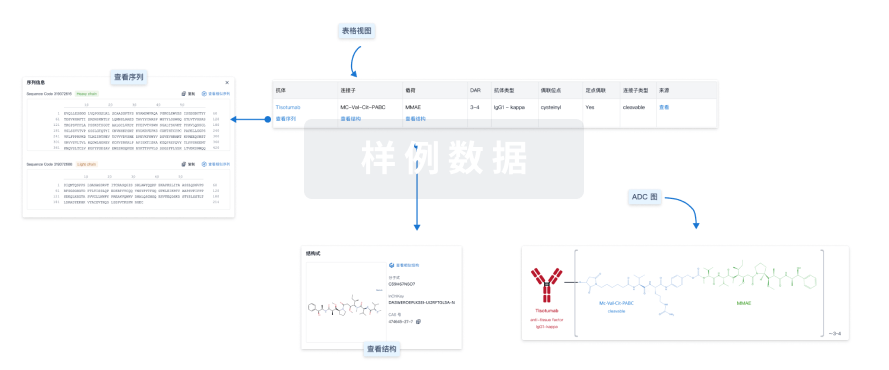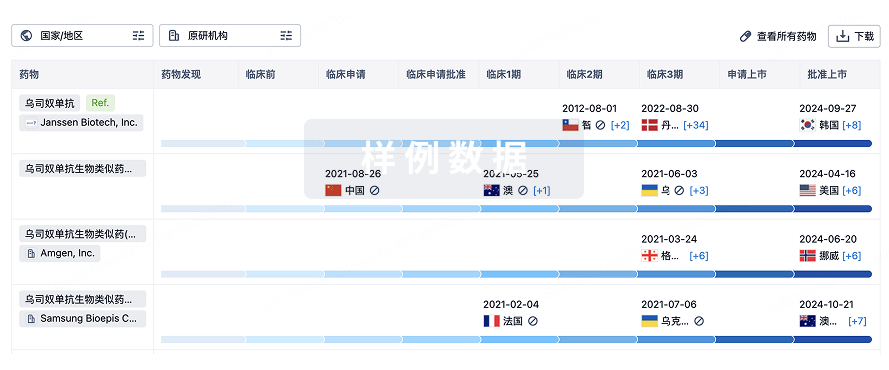预约演示
更新于:2025-05-07
Bevonescein
更新于:2025-05-07
概要
基本信息
非在研机构- |
权益机构- |
最高研发阶段临床3期 |
首次获批日期- |
最高研发阶段(中国)- |
特殊审评- |
登录后查看时间轴
结构/序列
使用我们的ADC技术数据为新药研发加速。
登录
或

Sequence Code 454008991

来源: *****
关联
4
项与 Bevonescein 相关的临床试验NCT06662097
Multicenter Open-Label Feasibility Study of Intraoperative Nerve and Ureter Visualization With Bevonescein in Patients Undergoing Minimally Invasive Abdominopelvic Surgery
Feasibility study of Bevonescein to highlight Nerves and Ureter in patients undergoing Minimally Invasive Surgery
开始日期2024-10-16 |
申办/合作机构 |
NCT06227585
Feasibility Study- REVEAL 475 System for Bevonescein-Assisted Intra-Operative Visualization of Nerves in Head and Neck Surgery
A feasibility study to evaluate the usability of the REVEAL 475 system in patients treated with bevonescein for nerve visualization during surgery.
开始日期2023-11-29 |
申办/合作机构 |
NCT05377554
ALM-488 for Intra-Operative Visualization of Nerves in Head and Neck Surgery
This protocol describes prospective, open-label, blinded, randomized controlled, multicenter pivotal studies to evaluate ALM-488.
开始日期2022-04-29 |
申办/合作机构 |
100 项与 Bevonescein 相关的临床结果
登录后查看更多信息
100 项与 Bevonescein 相关的转化医学
登录后查看更多信息
100 项与 Bevonescein 相关的专利(医药)
登录后查看更多信息
1
项与 Bevonescein 相关的文献(医药)Plastic & Reconstructive Surgery
Intraoperative Real-Time Fluorescence Labeling of Degenerated Facial Nerves with Bevonescein
Article
作者: Whitney, Michael A. ; Berman, Emma ; Crawford, Kayva L. ; Adams, Stephen ; Nguyen, Quyen T. ; Orosco, Ryan K.
3
项与 Bevonescein 相关的新闻(医药)2023-01-11
LA JOLLA, Calif., Jan. 10, 2023 /PRNewswire/ -- Alume Biosciences, Inc. has secured $13 million in Series B financing to advance its lead candidate, Bevonescein (ALM-488), in Phase 3 clinical trials. Alume, a leader in the field of nerve-targeted diagnostics and therapeutics, announced in August, 2022 that the first patient had been dosed in a Phase 3 pivotal study of ALM-488 for intra-operative visualization of nerves in head and neck surgery (NCT05377554). ALM-488 is a peptide-dye conjugate designed to highlight nerves with fluorescence in real-time during surgery. The Phase 3 pivotal studies are underway at major academic hospitals across the U.S.
With the $13 million raised in the Series B fundraising, together with funds raised in an earlier Series A financing and additional non-dilutive funding received through grants, the Company has raised over $30 million to fund the clinical development program for its lead candidate, advance its development portfolio and support potential regulatory filings.
ALUME BIOSCIENCES SECURES $13 M IN SERIES B FINANCING
"This is an important milestone for Alume. This funding brings us one step closer to improving intraoperative visualization of nerves for patients undergoing surgery, enabling Precision Surgery™" said Magda Marquet, a member of Alume's Board of Directors.
About ALM-488 ALM-488 is a proprietary fluorescent peptide-dye conjugate in the visible spectrum and can be visualized with fluorescently enabled instrumentation including filter modified loupe systems, portable handheld systems, microscopes and laparoscopes. ALM-488 binds to the extracellular matrix of nerves, allowing real-time nerve illumination during surgery. ALM-488 is expected to have broad surgical application due to unique characteristics of binding that are independent of myelin, which is an insulating layer around nerves. This allows ALM-488 to highlight multiple types of nerves including motor, sensory, and autonomic. Degenerated nerves, critically important during reconstructive procedures, are also highlighted with ALM-488. Surgeries where nerves are potentially at risk include procedures in the skull base, head and neck, and spine, and nerve sparing prostatectomy. In vivo studies also indicate that ALM-488 has adequate pharmacokinetic characteristics to support clinical utility for the labelling of ureters in urology, gynecology and lower abdominal surgical indications.
About Alume Biosciences Alume Biosciences is a late-stage clinical biotechnology company developing nerve specific targeting molecules. In addition to ALM-488, Alume is developing other nerve specific agents for diagnostic and therapeutic indications. The company was founded in 2017 and is headquartered in the Johnson & Johnson Innovation incubator JLABS @ San Diego. Learn more about Alume Biosciences at https://alumebiosciences.com
临床3期融资
2022-08-23
ALM-488 is a peptide-dye conjugate designed to fluorescently highlight nerves in real time during surgery
LA JOLLA, Calif., Aug. 23, 2022 /PRNewswire/ -- Alume Biosciences, Inc, a leader in the field of nerve-targeted diagnostics and therapeutics, today announced that the first patient has been dosed in a Phase 3 pivotal study of ALM-488 (NCT05377554). ALM-488 is a peptide-dye conjugate designed to highlight nerves with fluorescence in real time during surgery.
Continue Reading
Alume Announces First Patient Dosed in Phase 3 Pivotal Study for Intraoperative Nerve Fluorescence.
Tweet this
Alume Biosciences Announces First Patient Dosed with ALM-488 in Phase 3 Pivotal Study in Patients Undergoing Head and Neck Surgery.
"The successful initiation of this Phase 3 pivotal study is another major milestone for Alume. It marks the final phase of clinical trial testing for ALM-488 for patients undergoing Head and Neck Surgery" said Brett Berman, MD, chief medical officer at Alume Biosciences. "This study underscores our commitment to improve intraoperative visualization of nerves, enabling Precision Surgery™".
Alume successfully completed Phase 1/2 studies of ALM-488 in patients undergoing Head and Neck Surgery in 2021. The Phase 3 studies are being conducted at multiple academic medical centers throughout the US, and they are projected to be completed in 2023. "We look forward to exploring the power of ALM-488 as an intraoperative tool to identify nerves and potentially improve outcomes for our patients," said Karthik Rajasekaran MD, principal investigator at University of Pennsylvania.
About ALM-488
ALM-488 is a proprietary fluorescent peptide-dye conjugate in the visible spectrum and can be visualized with fluorescently enabled instrumentation including filter modified loupe systems, portable handheld systems, microscopes and laparoscopes. ALM-488 binds to the extracellular matrix of nerves, allowing real-time nerve illumination during surgery. ALM-488 is expected to have broad surgical application due to unique characteristics of binding that are independent of myelin. This allows ALM-488 to highlight multiple types of nerves including motor, sensory, and autonomic. Degenerated nerves, critically important during reconstructive procedures, are also highlighted with ALM-488. Surgeries where nerves are potentially at risk include procedures in the skull base, head and neck, spine, and nerve sparing prostatectomy. In vivo studies also indicate that ALM-488 has adequate pharmacokinetic characteristics to support clinical utility for the labelling of ureters in urology, gynecology and lower abdominal surgical indications.
About Alume Biosciences
Alume Biosciences is a late-stage clinical biotechnology company developing nerve specific targeting molecules. In addition to ALM-488, Alume is developing other nerve specific agents for diagnostic and therapeutic indications. The company was founded in 2017 and is headquartered in the Johnson & Johnson Innovation incubator JLABS @ San Diego. Learn more about Alume Biosciences at
Media contact: [email protected]
SOURCE Alume Biosciences
2021-05-12
LA JOLLA, Calif., May 12, 2021 /PRNewswire/ -- Alume Biosciences, Inc., a clinical stage biotechnology company developing nerve-targeted pharmaceuticals for surgical and therapeutic use, today announced that the U.S. Food and Drug Administration (FDA) has granted Fast Track designation for its lead compound ALM-488. ALM-488 is an investigational fluorescently labelled nerve targeting pharmaceutical being developed as an adjunct for the visualization of nerves at risk for injury during head and neck surgery. The Fast Track designation was approved by the FDA Division of Medical Imaging and Radiation Medicine (DMIRM), which is responsible for drug products used in the image-based diagnosis and monitoring of diseases.
Fast Track Designation Highlights the Urgent Need for Improved Intraoperative Nerve Visualization
Inadvertent nerve injury during surgical procedures can cause significant morbidity including numbness, paralysis, urinary incontinence and erectile dysfunction, depending on the clinical setting. "We are developing the GPS equivalent for intraoperative nerve visualization. ALM-488 has the potential to deliver significant benefit to patients undergoing surgery where nerves are at risk by fluorescently improving nerve contrast in real time," commented Quyen Nguyen, MD/PhD, Professor of Surgery at UCSD and CEO of Alume Biosciences. "Fast Track designation is an important milestone for Alume and we look forward to working closely with FDA to develop the next phase of our program."
Fast Track designation is intended to facilitate the development and review of drugs used to treat serious conditions and to fill an unmet medical need. Fast Track designation enables Alume to have more frequent interactions with the FDA throughout its drug development process, so that an approved product can reach the market expeditiously. The Fast Track designation was granted based on preliminary data from Alume's ongoing Phase 1/2 clinical trial of ALM-488 in patients undergoing head and neck surgery. The study is currently active at three sites including the University California San Diego (UCSD), Stanford Medical Center and Harvard-Massachusetts Eye & Ear. Alume anticipates trial completion in Q2 2021.
About ALM-488
ALM-488 is a proprietary fluorescent peptide-dye conjugate in the visible spectrum. ALM-488 binds to the extracellular matrix of nerves, allowing real time nerve illumination during surgery. ALM-488 is expected to have broad surgical application due to unique characteristics of binding that are independent of myelin. This allows ALM-488 to highlight multiple types of nerves including motor, sensory, autonomic and degenerated nerves important during reconstructive procedures. Surgeries where nerves are potentially at risk include procedures in the skull base, head and neck, spine, and nerve sparing prostatectomy. In vivo studies also indicate that ALM-488 has adequate pharmacokinetic characteristics to support clinical utility for the labelling of ureters in urology, gynecology and lower abdominal surgical indications.
About Alume Biosciences
Alume Biosciences is a clinical stage biotechnology company developing nerve specific targeting molecules for intraoperative imaging. In addition to ALM-488, Alume is developing other nerve specific agents for diagnostic and therapeutic indications. The company was founded in 2017 and is headquartered in the Johnson & Johnson Innovation incubator JLABS @ San Diego. Learn more about Alume Biosciences at
Media Contact:
Dan Harvey
dan.harvey@alumebiosciences.com
小分子药物快速通道
100 项与 Bevonescein 相关的药物交易
登录后查看更多信息
研发状态
10 条进展最快的记录, 后查看更多信息
登录
| 适应症 | 最高研发状态 | 国家/地区 | 公司 | 日期 |
|---|---|---|---|---|
| 造影剂 | 临床3期 | 美国 | 2022-08-23 | |
| 神经损伤 | 临床2期 | 美国 | 2024-10-16 |
登录后查看更多信息
临床结果
临床结果
适应症
分期
评价
查看全部结果
| 研究 | 分期 | 人群特征 | 评价人数 | 分组 | 结果 | 评价 | 发布日期 |
|---|
No Data | |||||||
登录后查看更多信息
转化医学
使用我们的转化医学数据加速您的研究。
登录
或

药物交易
使用我们的药物交易数据加速您的研究。
登录
或

核心专利
使用我们的核心专利数据促进您的研究。
登录
或

临床分析
紧跟全球注册中心的最新临床试验。
登录
或

批准
利用最新的监管批准信息加速您的研究。
登录
或

生物类似药
生物类似药在不同国家/地区的竞争态势。请注意临床1/2期并入临床2期,临床2/3期并入临床3期
登录
或

特殊审评
只需点击几下即可了解关键药物信息。
登录
或

Eureka LS:
全新生物医药AI Agent 覆盖科研全链路,让突破性发现快人一步
立即开始免费试用!
智慧芽新药情报库是智慧芽专为生命科学人士构建的基于AI的创新药情报平台,助您全方位提升您的研发与决策效率。
立即开始数据试用!
智慧芽新药库数据也通过智慧芽数据服务平台,以API或者数据包形式对外开放,助您更加充分利用智慧芽新药情报信息。
生物序列数据库
生物药研发创新
免费使用
化学结构数据库
小分子化药研发创新
免费使用

